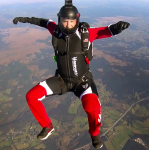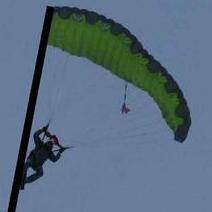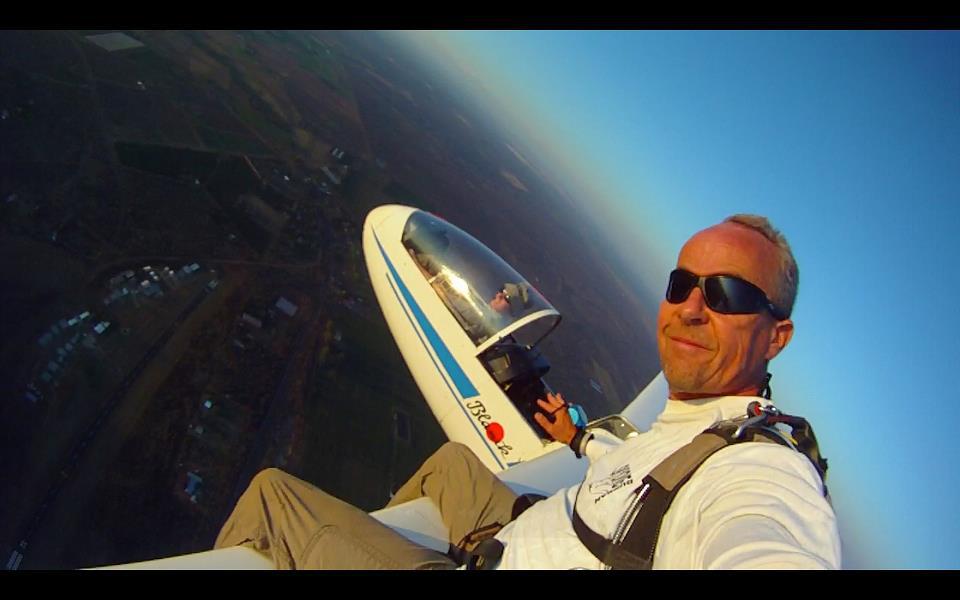
Deimian
Members-
Content
616 -
Joined
-
Last visited
-
Days Won
1 -
Feedback
0%
Deimian last won the day on August 13 2021
Deimian had the most liked content!
Community Reputation
43 NeutralGear
-
Main Canopy Size
90
-
Reserve Canopy Size
120
-
AAD
Vigil 2
Jump Profile
-
Home DZ
Zwartberg
-
Number of Jumps
1525
-
Tunnel Hours
44
-
Years in Sport
12
-
First Choice Discipline
Freeflying
-
Freefall Photographer
No
Ratings and Rigging
-
USPA Coach
No
-
Pro Rating
No
-
Wingsuit Instructor
No
-
And that's why speedflyers should pick a 90° angle from jumprun. Speedflying is not purely vertical, it does have an (admittedly small) horizontal component.
-
I had an OG90 in my 306 until it got "lost" after a cutaway. It fitted just right. The 120 is 3 sizes bigger. Sounds to me like trying that combination would be a horrible idea.
-
Speedflyers should go out first and pick a 90° angle from jumprun IMO. If they go in random directions they should not be speedflying. Speedflyers go considerably faster than freeflyers and of course belly jumpers. By the time the belly team is done setting up in the door and ready to jump the speedflyers are already half way down. By the time the belly team comes out of the hill the speedflyers are getting ready to slow down. We have one or two speedflyers jumping regularly in our DZ, and they always land about 30 seconds before anybody else, even though they do not have particularly small canopies. In our DZ we also put angle flyers out first. Even thought the falling speed difference is not so dramatic as with speedflyers, they can cover (and should) cover a lot of horizontal distance and be well away from jumprun and from underneath any other jumpers. The exit order should maximize distance between groups, so a fast-falling and long-distance-covering group leaving before belly groups puts everyone away from each other as much as possible. That requires of course decent navigation skills from the leader.
-
I have to partly disagree with that. Xfire is an awesome canopy, great openings, super responsive on harness, very good on rears, very fun to fly. But the recovery arc is quite short compared with Katana or most cross-braced canopies, which makes it dangerous to swoop with it, as you have to turn quite close to the ground. At least that has been my experience in 500 jumps with Xfires of different sizes.
-
Seems to me like new more "clicky" buttons, and USB-C instead of microUSB for charging.
-
I think the variability is too high to get anything really useful out of it in a forum. Besides accounting for WL and canopy, you have to consider the altitude of the dropzone and the speed of the turn (are people snapping the turn or doing a slow controlled turn whipping it at the end?). And of course the style of turn (just fronts, just harness, both, rears). Also some people start with double fronts before they turn. Which altitude do you take there, when you start doing double fronts or when the turn actually starts? For what is worth I turn between 900 and 650 feet on my Gangster 90 at around 2.05 WL. When I am late I make a much quicker turn than when I am early on that range. At 900 feet I am hanging on double fronts and start turning with harness and fronts. The last 90° are quicker than the first 180.
-
No, of course not. But this particular dropzone did (and grew up to Caravans today, after a phase with Pilatus Porter). Sorry if it was not clear, didn't mean to imply that all dropzones were small in the 80s.
-
We have a guy at our dropzone. He is a lovely guy, very nice fellow. He started jumping in the late 80s/early 90s with his wife. They both quit when the got their kids. He started again like 6 years ago. One day, after jumping, his wife was there. At some point in the conversation she said "I don't get why you need all these rules, patterns and recommendations. We were all able to fly our canopies safely before without any of that." I think she didn't realized how much of a difference it makes, to have 18 people in the sky at the same time with wingloads from 0.9 to 2.5, with respect to her times, when they had 4 people in the sky all of them with 200 sqft canopies. The size of the loads and the variety of wingloads makes proper canopy flying critical. Everyone should fly their canopies with everyone else in mind. And that involves in many cases not spiralling just for shit and jiggles. If you want to spiral down when you have 3 other canopies in the sky and you are perfectly aware of where they are, and how they fly, go for it. But that simply does not apply in bigger dropzones with loads with massive differences in wingloads.
-
Totally agree (in the context of canopy flying). But it is difficult to maintain vertical separation if there are spiralling canopies in the pattern. Maintaining vertical separation can become quite difficult in that situation. As you said, I guess that you and me understand "spiralling" slightly different. I understand spiralling as quick turns of at least 360 degrees, often more. All the points you mentioned are totally valid, but for me those are canopy exercises that are typically recommended to be done in hop and pops with clear airspace. I wouldn't recommend removing one brake in a normal load with 18 people, as an example. Many other exercises (like harness turns, swoop practices) are rarely more than 270 degrees during a full altitude jump, and that is fine IMO in a normal load, provided that you don't get on the way for others. A typical freefall time for belly flyers is about 60 seconds. Freeflyers fall for 45 to 55 seconds. So normally the last belly group opens more or less at the same time than the first freefly group. You hit the nail on the had when you said "it doesn't take long for the [...] heavier loaded canopies to be under [...]". But that does not hold true with spiralling canopies, as they are constantly changing their fall rate. That is exactly the source of the problem. I explained all the relevant points I could think of as good as I could, none of them were "I have mad skillzz". Let me summarize it, maybe it was too much: Canopy collisions are a real problem. The point is not "I have mad skillz, get out of the way", the point is "canopy collisions kill people, everyone should get out of everyone else's way". I was advocating for conscious flying and proper "canopy etiquette" long before I was jumping heavily loaded canopies. Heavily loaded canopies can't stop falling from the sky until other canopies land, but other canopies can stop spiralling if there is potential for conflicts. Do you have any counter argument to that, or is insinuating that I am a hot shot wannabe and a dick all you have?
-
Spiralling should be heavily discouraged everywhere with more than 2 canopies in the air, except if you are the lowest one and with a fall rate in full flight comparable to the ones above you. It develops 0 skills, it is an unsafe practice for the one doing it (can collide with other canopies that he/she didn't see) and for others (don't know where to go because the one spiralling is not flying predictably) and it gets boring rather quickly, so it is not even fun compared with other things you can do under canopy if you have the skills for it. To minimize conflict under canopy, you want to maximize both horizontal and vertical separation, and "pipeline" the canopies landing. A typical situation in medium size dropzones is having 18 canopies in the air at the same time. If you are in the middle of the bunch and have a canopy loaded at, let's say, 1.5, the safer way for everyone is if the heavily loaded canopies after you overtake you up high, and the vertical separation between these 2 groups is not reduced after that. That way there are no conflicts close to the landing pattern. If you start spiralling they can't overtake you at a safe altitude, since you artificially accelerated your fall rate, just to stop to your normal rate as soon as you stop spiralling. If you start-stop and then start and stop again, that makes it even worse. Like a car in the highway driving on the left lane and slamming on the brakes just to swerve to the right, accelerate, move again to the left lane and slam the brakes again. So the ones behind with highly loaded canopies need to do either of these: - Overtake you in the pattern. Take into account that the *last* turn for many canopies starts at 1000 feet. So your pattern starts when theirs finishes. Nobody wants to overtake or be overtaken at this point, every one should be focused on the ground and landing safely, not on canopy slalom. - Land out. Not always an option, depends on the DZ. - Hold on to breaks as much as possible, forcing everyone behind to do the same. This is not always possible, as even in brakes some canopies that are heavily loaded fall faster than other lightly loaded canopies in full flight. All these options are bad. This situation is quite common, as belly flyers typically fly lightly-to-medium loaded canopies and exit first due to free fall drift, and freeflyers have a higher tendency to fly medium-to-highly loaded canopies and exit after the belly groups. The exit order helps to keep horizontal separation between groups, but minimizes vertical separation as both groups open at a similar time and altitude. To fix that heavily loaded canopies should land first for everyone's sake, but can't do that if the lightly and medium loaded canopies are spiralling. Some would blame the small canopy and say they have the right to spiral down. Others would blame the spiralling pilot for lack of canopy etiquette and being equally skill-less and a dick.
-
That's quite a statement. All these canopies have different opening, flight and flare characteristics. In some cases very different. Not to mention company support and resell value.
-
I think we are going to disagree on this. Basic aerodynamics are pretty easy stuff and you don't need much to move from 0 to a level that allows you to go fast and far. Optimizing it to the point it is now is a completely different story of course, but creating airfoils and testing them, and simply go by trial and error (and a bit of intuition) is not complicated. You can work out 70% of the stuff like that. The problem now is not about electricity. Electricity and electric powertrains are not the complicated part in having mainstream electric airplanes. The challenge is in the chemistry of the batteries. And that can't be worked out with pencil and intuition IMO. The analogy pretends to reflect simply that you can't make stuff out of nothing. Hoping that a given technology can evolve limitless is very naïve IMO.
- 316 replies
-
- aircraft maintenance
- electric
-
See more
Tagged with:
-
Sure, and that's not good. But I think it is not the same asking "which kind of canopy hold longer in rears", which is valuable knowledge, and "I have 200 jumps, I am ready for a VC90, where can I get one without too much supervision?". OP has been in the forum since 2008, so I would also hope he is not a dumb hot shot. But maybe I am too naïve
-
I disagree. Engineering and technology are like a gold mine. If there is a gold vein, you can extract gold with simple tools. You'll be faster with power tools than with a mattock and a shovel, but in both cases you can get lots of gold in short time. That's what happened 100+ years ago. But if the mine runs dry you need to dig much more to get a tiny bit of gold out of it, if at all, even with the best possible tools. That's where we are now. Aviation started at a vein, and slowly but surely the mine is running dry. It ain't magic, there are limits to what can be done, and the closer you get to the limit the more difficult it gets to push the envelope. You can't make gold out of nothing. But if you are an optimist you can always hope for finding a new vein that would help to push things faster. Or maybe there is still enough gold to be found, spread in some cubic kilometres of useless rock. Maybe there is a new battery technology about to be discovered, or maybe we can refine sufficiently the existing technologies to make the electric aircraft a practical reality. But maybe not, and that'd be it, the electric airplane would never be mainstream.
- 316 replies
-
- aircraft maintenance
- electric
-
See more
Tagged with:
-
This is solid advice. But this particular question can be at least partly answered without a coach IMO, of course taking into account that communication in person can be more accurate than in a forum, since the chance for miscommunication is lower in person. To answer the original question: There are many many things that influence how long you can keep in rears. It is not simply a matter of "Crossfire vs JFX". Let me go over some of them. The fact that a canopy is trimmed flatter than another one, does not mean that it holds longer in rears. It is almost the opposite. When you pull on your rears you are effectively altering the trim of the canopy. If the trim is already flat, you have less giggle room to produce changes in the canopy behaviour without stalling it. Cross-braced canopies are more efficient due to the way the top skin holds its shape (21-27 "compartments" instead of 7-9 cells). That means that all other things being equal, they create more lift, which means that the same input on rears have a greater effect in producing lift at a given airspeed. Another thing that greatly affects how long you can hold in rears without sinking is airspeed. The higher the airspeed, the more lift the canopy produces, so the longer you can keep on rears. So you might hold longer on a Crossfire going at a certain speed, than in a JFX going at half of that speed. But JFX is a more steep canopy, so at the same wingload you are probably going to be faster on a JFX than on a Crossfire. Yet another thing is parasitic drag in the trailing edge. So a canopy with miniribs will have less parasitic drag, and is therefore more efficient, and can hold longer on rears than one without. On that sense, a JFX 2 is better than a JFX 1 for instance. So, to summarize, the *chances* that you can hold longer on rears on a JFX than on a Crossfire are very high, but you can't say that in all circumstances you can hold longer on rears on a JFX.






